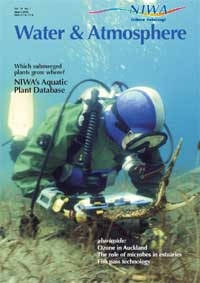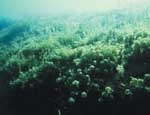PDF of this article (1 MB)

Ian Duggan John Clayton Mark James David Rowe
Aquatic plants are important in fish–invertebrate interactions in lakes and both the species and density of these plants can affect their role.
Submerged aquatic plants – also known as macrophytes – are a familiar sight in lakes. Less well known is the importance of these plants in lake ecosystems. They are known to provide hiding places for small fish from larger predatory fish. Some fish feed directly on the plants, while others feed on the large populations of invertebrates that can live amongst macrophytes. Plants may also provide a refuge for the invertebrates by hindering the activity of predatory fish. Invertebrates living amongst macrophytes include filter feeders that can remove algae from the water column. Also, invertebrate grazers such as snails eat algae and detritus from the surfaces of plants, which could otherwise be smothered. In addition, plants use up nutrients from the water and their roots help to stabilise sediments on the bottom.
Interactions with invertebrates, along with nutrient use and stabilisation effects, are considered to be very important in maintaining clear water states in shallow lakes. ( see “Biological interactions in lakes”.)
However, some plants fulfil these various roles better than others. Both species and plant density can affect the amount of refuge provided and whether fish are able feed amongst plants. Surveys of invertebrates in weed beds have shown that there tend to be more invertebrates when macrophytes are more complex or grow more densely.
In this study, we examined whether different species of macrophytes can affect the distribution of invertebrates and their accessibility to New Zealand native fish. We looked at how a native aquatic plant (a charophyte – Nitella) and an introduced weed (hornwort – Ceratophyllum demersum) (see “Plant introductions”) compared as habitat for invertebrates and native fish, using a field survey and laboratory experiments.
Field survey
Teachers: this article can be used for Biology L7 A.O. 7.1 (a). See other curriculum connections at www.niwa.co.nz/pubs/wa/resources
Invertebrates were sampled from established Nitella and hornwort beds in Lake Rotoaira at the southern end of Lake Taupo in the North Island.
On average, Nitella harboured more invertebrates (15.5 individuals per gram dry weight of plants) than hornwort (8 individuals/g). Higher invertebrate abundances on charophytes are consistent with other New Zealand studies. The comparatively high average invertebrate density on Nitella was largely due to extremely high numbers of invertebrates recorded at the highest Nitella densities. No change in invertebrate numbers with plant density was observed for hornwort.
It seems reasonable to suggest that the greater invertebrate abundance on Nitella is equivalent to more food available for fish. However, our laboratory experiments revealed a different story.
Laboratory experiments

We tested the effects of different densities of hornwort and Nitella on prey accessibility using the common bully (Gobiomorphus cotidianus), a common native fish inhabiting the shallow margins and bottoms of New Zealand lakes.
Hornwort and Nitella were each placed in aquaria at five densities that covered the ranges found in the field study. We used the amphipod Paracalliope fluviatilis as prey and added these small crustaceans to the aquaria at five densities. Single fish were allowed to feed on the amphipods for five minutes, after which we counted how many amphipods remained in the aquaria. The number of prey animals eaten was used to calculate the feeding rate.
Increases in plant density resulted in a general reduction of feeding rates for both plant species at most prey densities (see graph), especially for Nitella at the highest stem densities, even at high prey densities. We think this was because the fish could neither swim properly nor see very well in such dense plant growth. These stem densities were fairly typical of those growing in Lake Rotoaira. It therefore looks as if reduced feeding by fish may explain the very high invertebrate abundance at high Nitella densities in Lake Rotoaira.
Very dense hornwort did not have the same effect. Also, hornwort was not usually so dense in the field – only three of the ten samples from Lake Rotoaira had densities greater than 1000 stems/m2. It seems that bullies can forage freely amongst the hornwort densities typically growing in Lake Rotoaira. Hence our field survey showed fairly uniform numbers of invertebrates with increasing stem density.
Note that we found very high variability among replicates and few of the results were statistically significant. Therefore the results are tentative at this stage.
More recent trials have examined the same macrophyte species, using greater replication and with the addition of Egeria densa. These trials have shown patterns similar to those presented here, including that Nitella at the highest densities can significantly decrease prey accessibility.
Information for management


The results of trials like these have potential applications in lake management. For example, macro-phytes may be manipulated to restore the clarity of shallow lakes. The effectiveness of such action may be improved if it is possible to predict those macrophyte species that provide the best refuges for filter-feeding invertebrates that can control algal populations. Another example is that management for particular macrophyte species, optimum densities of certain macrophytes species, or the provision of more accessible areas (for example, greater edge areas) may benefit commercial or sport fisheries.
Future research could examine different combinations of fish, invertebrates and macrophytes, depending on particular lake management questions.
What we do know already is that the introduction of invasive macrophytes may have implications to lakes beyond simply a displacement of native vegetation. These interactions need further research to underpin advice to lake managers.
Ian Duggan was formerly at NIWA and is now based at the Great Lakes Institute for Environmental Research, Canada; John Clayton, Mark James and David Rowe are based at NIWA in Hamilton.
This research was funded by NSOF and augments the FRST-funded Aquatic Plant Management programme C01X0021. Permission to access the lake was provided by the Lake Rotoaira Trust.
Plant introductions
Since the arrival of Europeans in New Zealand, many aquatic plant species have been introduced and become established, in many cases displacing our native aquatic plants. One example is hornwort (Ceratophyllum demersum). This submerged aquatic weed was first recorded in New Zealand in 1961 and is still spreading. Its physical structure differs from that of native aquatic plants and it forms monospecific beds with a dense canopy that displaces native submerged vegetation such as charophytes (e.g., Nitella and Chara species). Such a shift in plant composition and habitat structure may affect the accessibility of invertebrate prey to New Zealand’s native fish populations, which predominantly feed on the lake bottom or in vegetated areas. There have been concerns over the spread of hornwort in both Lake Rotoaira and in Lake Taupo, hence the selection of Lake Rotoaira for the study described in this article. Hornwort has recently been recorded for the first time in the South Island and has the potential to have a huge impact on the ecological structure and biological function of many South Island lakes.
Biological interactions in lakes

The arrows (positive or negative) show interactions between invertebrate-feeding fish, invertebrates and macrophytes. For example, fish have a negative effect on invertebrates by eating them. The relationship between macrophytes and invertebrates is beneficial in both directions: plants provide habitat for invertebrates and invertebrates graze off algae that could smother the leaves. The dashed line indicates the interaction between fish and invertebrates that is affected by macrophytes. Very complex or very dense macrophytes tend to discourage fish, allowing invertebrate numbers to grow.
